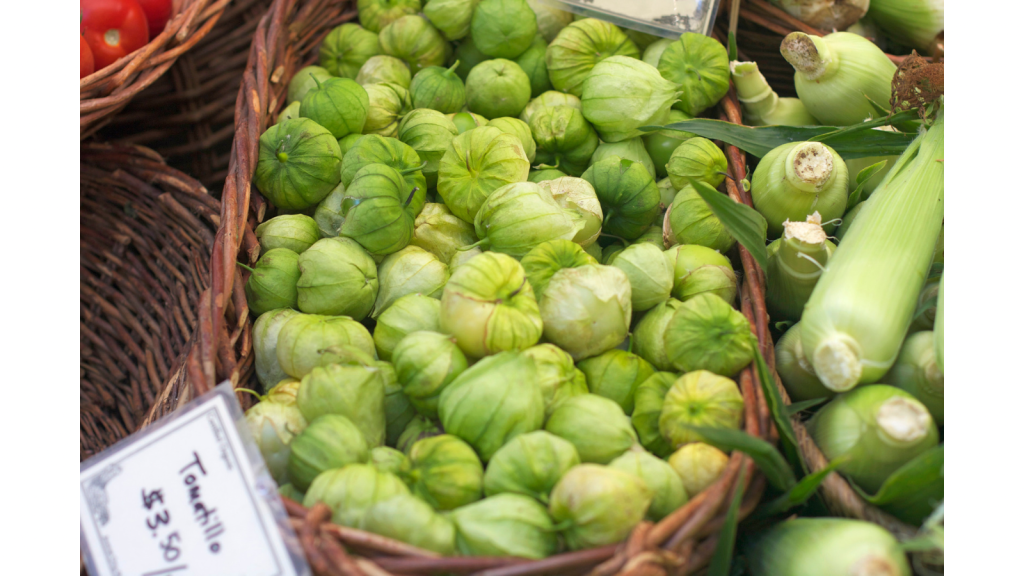What Are Tomatillos and How To Cook With Them
This post may contain affiliate links.
Tomatillos, or Mexican husk tomatoes, are small green fruits that add a tangy and vibrant flavor to various dishes. They are prevalent in Mexican cuisine, the star of many salsas and sauces, and favored throughout the culinary world for their distinct flavor. With their marked tartness, tomatillos are a versatile ingredient that can elevate your cooking.

Tomatillos resemble unripe green tomatoes enveloped in a papery, leafy husk. The vibrant hue of the fruit is truly eye-catching, although it does mellow when cooked.
Tomatillo vs. Tomato
Although the Spanish translation of tomatillos is ‘little tomato’, these two fruits are different and, in most cases, can’t be used interchangeably.
Tomatillos are slightly more acidic and less sweet than a tomato. They are not juicy like a ripe tomato and have a more firm, less watery inside. Tomatillos are tart and bright tasting, whereas tomatoes are generally sweeter.
You can find tomatillos year-round, but their primary season is early summer through fall, just like tomatoes.
What Do Tomatillos Taste Like?
If you’ve ever tasted unripe green tomatoes, you might be familiar with the tartness of tomatillos. You can enjoy tomatillos either raw or cooked. When roasted, tomatillos’ tart flavor mellows, and they become sweeter. This flavor profile is their true superpower.
Tomatillos are most popular in recipes such as salsa verde, a bright condiment often used to cut through the fatty, rich taste of braised meats and beans. Like the wide use of limes in Mexican cuisine, the astringency helps balance more hearty fare. Without this, a recipe can feel too heavy. Depending on how tart you want the accompanying salsa verde, you can keep the tomatillos raw or roast them before creating your salsa.
They pair well with avocado, chiles, cilantro, garlic, lime, onion, and oregano.
Tomatillos are a common ingredient in chilaquiles, enchiladas, salad dressings, salsa, and Mexican, southwestern, and Tex-Mex cuisine.
How To Select Tomatillos
When choosing tomatillos, look for firm, bright green fruits with intact husks. The husk should be fitted and slightly dry.
If ripe, peel back a little of the husk until you can see the green fruit. Perfect tomatillos will be firm, without blemishes or soft spots. Try to get tomatillos that have filled their husks, a good sign that they are more flavorful than less mature fruit.
Unripe tomatillos are very sour, and their flavor will mellow as they age. As the tomatillos ripen, the husk will loosen, and the tomatillo will become less firm to the touch, though not squishy. Ripe tomatillos will feel like slightly unripe tomatoes; too much give means that the tomatillos are overly ripe.
Store tomatillos in a paper bag or the refrigerator for up to two weeks.
How To Cook
When ready to use, remove the papery husk. You will notice a sticky residue outside the tomatillo, which you should rinse off before eating. Once cleaned, tomatillos are ready to be used in various recipes.
Salsa Verde is a classic Mexican condiment made with tomatillos. It’s a versatile and tangy sauce that pairs well with sofritas, grilled meats, or as a dip for tortilla chips.
Salsa verde is traditionally made with tomatillos, lime juice, onions, jalapeno peppers, and cilantro. Depending on how tart you want your salsa, you can enjoy the raw tomatillos or roast them first. As with any salsa, it’s also customizable to spice level, depending on how many jalapeno peppers you add. Those, too, can be roasted first to mellow their heat level. Roasting is an excellent option for those who enjoy the flavor of salsa without the spiciness.
However, tomatillos are more than just salsa potential. They can be transformed into velvety sauces and curries, lending a creamy texture and a delightful tang when you need a bite of something acidic. Harness their sharpness by incorporating them into vinaigrettes for salads.
Or, thinly slice them like tomatoes and enjoy on toast with creamy ricotta cheese, honey, good olive oil, and a pinch of salt and pepper. For a steak side, grill tomatillos alongside onions, creating a flavorful duo, then serve as is or roughly chop with fresh cilantro for a chunky topping. That combination works with any protein or your favorite vegan tacos.
Tomatillos can be blended into bean chili or posole, adding layers of flavor and brightness to balance these rich stews.
For a tasty salad dressing, roast tomatillos until soft, then blend with sour cream, buttermilk, and avocado. Heighten the flavor with added fresh herbs and use it as a refreshing drizzle on nachos, enchiladas, or tamales.
Where To Buy
You can find tomatillos at most well-stocked grocery stores, often near the tomatoes, peppers, or avocados, in the produce section. Mexican or Latin American grocery stores will have them if you cannot find them at your local grocery store. These stores typically offer a more comprehensive selection and cater to authentic ingredients.
If you can’t find tomatillos fresh, purchase them canned. You can use canned tomatillos in salsas and sauces just like fresh, but you’ll need to drain any liquid from the can first.
If you want canned tomatillos as a substitute, an 11-ounce can replace a pound of fresh fruit. On average, there are 15-17 small tomatillos in one pound or about 9-10 medium tomatillos in one pound.
Nutrition Benefits of Tomatillos
As with other fruits and vegetables, tomatillos are mostly carbohydrates, with smaller amounts of fat and protein. They are relatively low in calories, with about 20 per ½ cup serving of raw tomatillos.
Tomatillos are a rich source of vitamins C and K, along with the carotenoids lutein and zeaxanthin, which have known eye health benefits.
Are Tomatillos Toxic?
Tomatillos are a nightshade family member – as are tomatoes, peppers, potatoes, and eggplants and contain a toxic substance called solanine. While the word toxic sounds scary, it’s not something most individuals have to worry about.
Solanine is present in nightshades, including tomatillos, but it’s at a different level in each variety. For example, unripe potatoes contain more solanine than ripe tomatoes, and unripe tomatillos have more solanine than ripe ones.
However, the level of solanine is still safe, especially when consumed in moderate quantities, as in many traditional Mexican dishes like salsa verde. If you have a known solanine sensitivity, then it’s best only to eat ripe tomatillos.
Are Tomatillos Easy To Grow?
Tomato gardeners may wonder, can you grow tomatillos? Growing tomatillos in your backyard ensure that you always have plenty to cook with, and they are a beautiful plant!
While tomatillos require similar care to tomatoes, they are much more forgiving. They are less susceptible to fungi than tomatoes and are more drought and heat-tolerant. As they are a plant native to Mexico, they can withstand hotter, dryer conditions.
For urban dwellers, you can grow tomatillos in pots – just like tomatoes. They grow similarly and must be staked as they become taller to prevent collapse.
You can use your tomatillos in any culinary dish once they have ripened. Start with the classic salsa verde, then branch into sauces and dressings. The more you experiment with tomatillos, the more comfortable you will become with cooking them.
This article originally appeared on Wealth of Geeks.
Alex Caspero
Alex Caspero is a Registered Dietitian,New York TimesBestselling Chef, and founder of Delish Knowledgeand Plant-Based Juniors. She focuses on making whole-food, vegetarian eating deliciously simple. Her nutrition expertise and must-make recipes have been featured in Forbes, Today, The Washington Post, Parents, Vogue, Food Network, and more.
